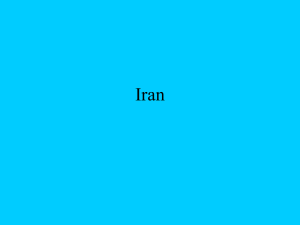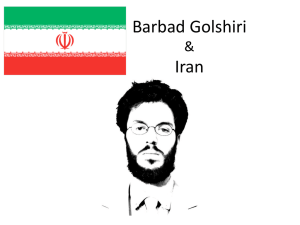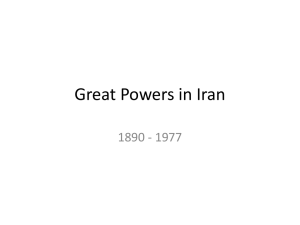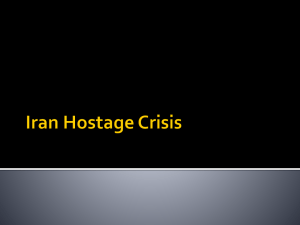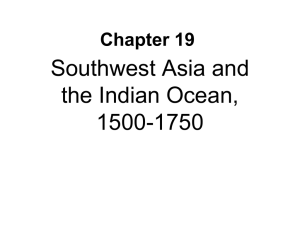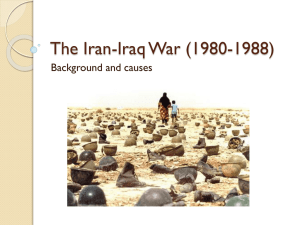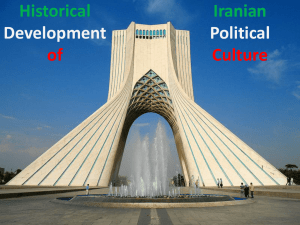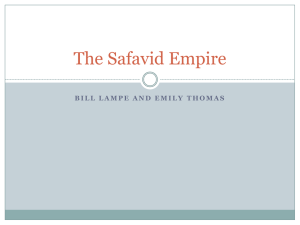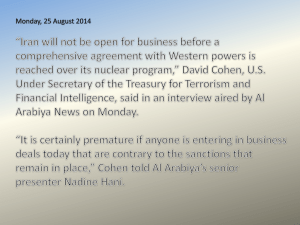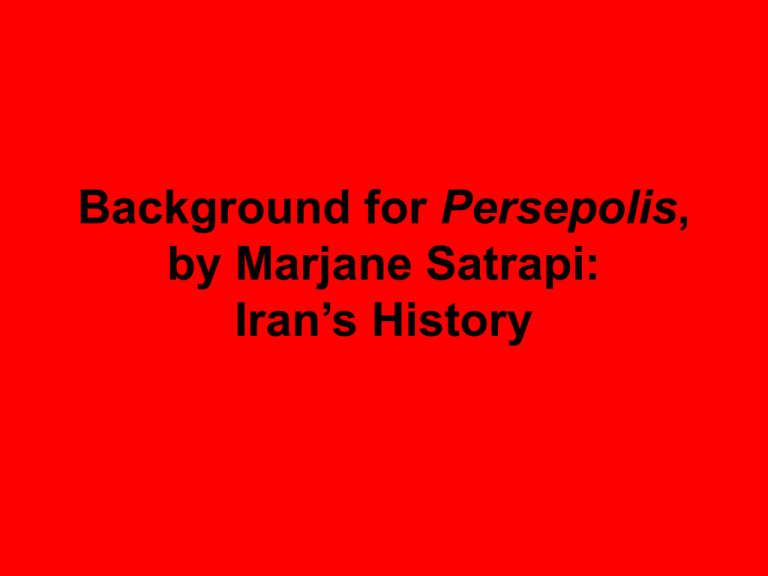
Background for Persepolis,
by Marjane Satrapi:
Iran’s History
Introduction
• “Iran” comes from the word “Aryan”
• Aryans settled here in 1500 B.C.
• Descendents were the Medes and the
Persians
• Eventually, whole territory became
known as the Persian Empire
• 1935 Reza Shah changed the name
from Persia to Iran
Ancient Iran: Dynasties and
Invasions
• Though Iran has a great history of building
vast empires, many groups over the years
fought to seize control of the country.
• During Darius’ reign in 518 B.C., Persepolis
was built.
• Persepolis was a vast palace complex that
included temples, government buildings, and
a place for special ceremonies.
Persepolis
• Construction took more than 200 years and
represented the Persian Empire’s might
• Carvings were covered in gold, bronze, and lapis
Persepolis
• In the 4th century B.C., Alexander the Great burned
the royal palace at Persepolis, and made Persia part
of his Greek Empire.
• Today all that remains is the stone underneath; still,
this is the most visited site in Iran.
Qajar Dynasty 1794-1925
• Early 1800’s, Russians wanted
access to Persian Gulf and the
British wanted to keep their trade
route to India.
• The Qajars needed the money, so
they made deals with both
countries.
• Both the British and Russians:
banks, mining, control of Iranian
industries.
• The Qajar shahs grew wealthy, but
the Iranian economy declined.
• The Iranian people grew angry and,
in response, the shah at the time
(see picture) created a constitution.
• Thus, Iran’s first elected legislature,
the Majlis, was formed.
1908
In 1908, oil was discovered in Iran; the British
took control over the oil industry, and they took
most of the profits.
The people of Iran obviously did not like this
arrangement and discontent spread.
Reza Shah
Reza Shah Pahlavi was a general in the
Persian army who:
• Led the coup d’etat to overthrow the
last Qajar shah in 1923.
• Sought to modernize Iran.
• Reduced the power of the clergy.
• Built a national education system and
opened the University of Tehran.
• Gave women the right to vote for the
Majlis and freed them from Islamic
obligation to wear the head-to-toe
chador at all times. Men began
wearing suits instead of traditional
Iranian clothes.
• Ordered the first railroad to cross the
country to be built.
World War II
The Allied forces, especially
Britain and the Soviet Union,
wanted to ensure that
Iranian oil would continue to
reach the front.
Both nations sent troops into
Iran to prevent Nazi
Germany from gaining
control there.
However, Reza Shah favored
Germany because 1) he
resented British and Soviet
intrusions and 2) many
Germans were living and
working in Iran at the time.
Mohammad Reza Shah
In 1941, the British and
the Soviets forced Reza
Shah Pahlavi out of
power.
His twenty-one year old
son, Mohammad Reza,
replaced him as shah
(see pic).
Early on, he was heavily
influenced by the
British, who still
controlled the AngloIranian Oil Company.
Most of the money
produced by Iran’s oil
industry went to the
British.
Battle Over Iran’s Oil
• In 1951, Iranian politician Muhammad Musaddiq spoke
out against the British control and many supported this
stance.
• In response, the Iranian government nationalized the oil
industry.
• In 1953, the British began a boycott of Iranian oil.
• People lost jobs and the nation’s oil industry suffered.
• Supporters of Musaddiq (now Iran’s prime minister)
fought supporters of the shah. The shah fled the country.
• The British convinced the U.S. to help remove Musaddiq
from office.
• He was forced out and Reza Shah returned.
• Oil industry was denationalized, only now the British did
not control it all. The U.S. now had 40% control.
Modernization and Corruption
• Like his father, Reza Shah wanted to
modernize the country—schools, hospitals,
roads, etc. Women could now hold public
office.
• He also, however, grew more and more
dictatorial.
• The shah outlawed all political parties but his
own. Freedom of speech was limited—those
who spoke out against him were imprisoned,
while some were killed.
• Meanwhile, the economy suffered.
Opposition to the Shah’s Rule
Huge protests against the shah
became common.
Opposition grew in the 1970s,
especially among two
groups:
1) Communist-inspired
students and intellectuals
who wanted genuine and
democratic reform
2) Muslim fundamentalists, or
believers in the strictest
possible interpretation of
Islamic doctrine. Many
religious leaders felt his
changes were a threat to
Islam.
Khomeini
A Muslim leader named
Ayatollah Khomeini was
one of the shah’s most
vocal opponents.
He condemned the shah
for being corrupt and in
the pocket of the United
States.
The Islamic Revolution
The Shah fled in 1979.
Ayatollah Khomeini became
“real” leader
Declared Iran an Islamic
Republic—the clerics must
rule.
Iran became a true
theocracy: official religion
is also the supreme
government authority.
Khomeini and The Islamic
Revolution
Khomeini ruled with an iron fist:
-Death to those who supported/worked with the shah
-Women forced to wear chador and walk only with male
relative in public
-The University of Tehran closed for two years
-Newspapers shut down
-History books re-written
-Schools divided by sex
-Many Iranians fled (Westernized intellectuals, those
associated with the shah, or those who simply had
grown accustomed to the Western style)
Iran Hostage Crisis
In 1979, Reza Shah
allowed to enter U.S.
Iranian students went to
U.S. embassy in Tehran
and took 50 people
hostage.
They demanded that the
U.S. send the shah back
to Iran to stand trial, but
the U.S. refused.
The hostages were held
for more than a year.
Iran-Iraq War
In 1980, Iraq invaded
Iran.
Saddam Hussein
wanted to take
advantage of Iran’s
chaos
War lasted eight years
and affected cities,
oil facilities, people
Iran-Iraq War
Each country maintained an
army of 600,000
To keep forces staffed, both
sides enlisted boys as
young as 11 or 12 years
old
Each side claimed this as a
“holy war.”
Cease-fire was declared in
1988
After Khomeini
Khomeini died in 1989 and millions of
people mourned in the streets.
Sayyid Ali Khamenei took over as
spiritual and political leader of Iran,
and he still holds title of “supreme
leader”
A moderate cleric named Ayatollah
Muahmmad Khatami became
president in 1997.
Hoping to improve the status of
women and give more people a
voice, he was also friendlier to the
West. He was unable to accomplish
much due to resistance from more
conservative and powerful
government leaders.
Today
In 2005, Moahmoud
Ahmadinejad, the
former mayor of Tehran,
won the presidency.
He turned Iran in a more
conservative direction.
Iran continues to have
strained relations with
the West, especially the
United States.
In 2009, he won reelection though many
feel electoral fraud took
place.
Quiz!
Reza Shah attempted to modernize Iran
in all of the following ways except:
a) He build a national education system.
b) He gave women the right to vote for the
Majlis.
c) He freed women from the Islamic
obligation to wear chadors.
d) He discontinued the 2 years of military
service all Iranian men were required to
serve.
e) He reduced the power of the clergy.
The Islamic Revolution of 1979 caused all
of the following events EXCEPT:
a) The country’s supreme government
became truly democratic
b) Women were forced to cover their hair
and wear chadors
c) History books were rewritten
d) Families who had come to enjoy Western
freedoms fled to Europe and the U.S.
e) The University of Tehran was closed for
two years
Reza Shah (II) also wanted to modernize
the country, and he made efforts to do
so, however…
a) He grew more dictatorial as time went on
b) Many believed he was corrupt
c) He outlawed all political parties but his
own
d) Those who spoke out against him were
imprisoned or killed
e) All of the above
True or False?
During World War II, Reza Shah was forced
out of power by Germany.
False: The British and the Soviets forced
him out of power.
True or False?
Strict fundamentalists were upset with Reza
Shah because of his looser interpretation
of Islamic doctrine.
True!
True or False?
Iran began the Iran-Iraq war in 1980 in order
to expand its territory.
False!
Although this was the stated reason, the real
reason was that Saddam Hussein thought
he would be able to bring down the chaotic
Iranian government.
True or False?
After the Shah left Iran in 1979, many
people who had worked with him were
considered heroes and were exalted by
the new leaders.
False: Under Ayatollah Khomeini’s rule,
many people who had worked with the
Shah were put to death.
Bibliography
Milivojevic, JoAnn. Iran. New York:
Children's P, 2008.
Sanders, Renfield. Iran. New York:
Chelsea House, 1990.
Taus-Bolstad, Stacy. Iran in Pictures. New
York: Lerner Group, 2004.



